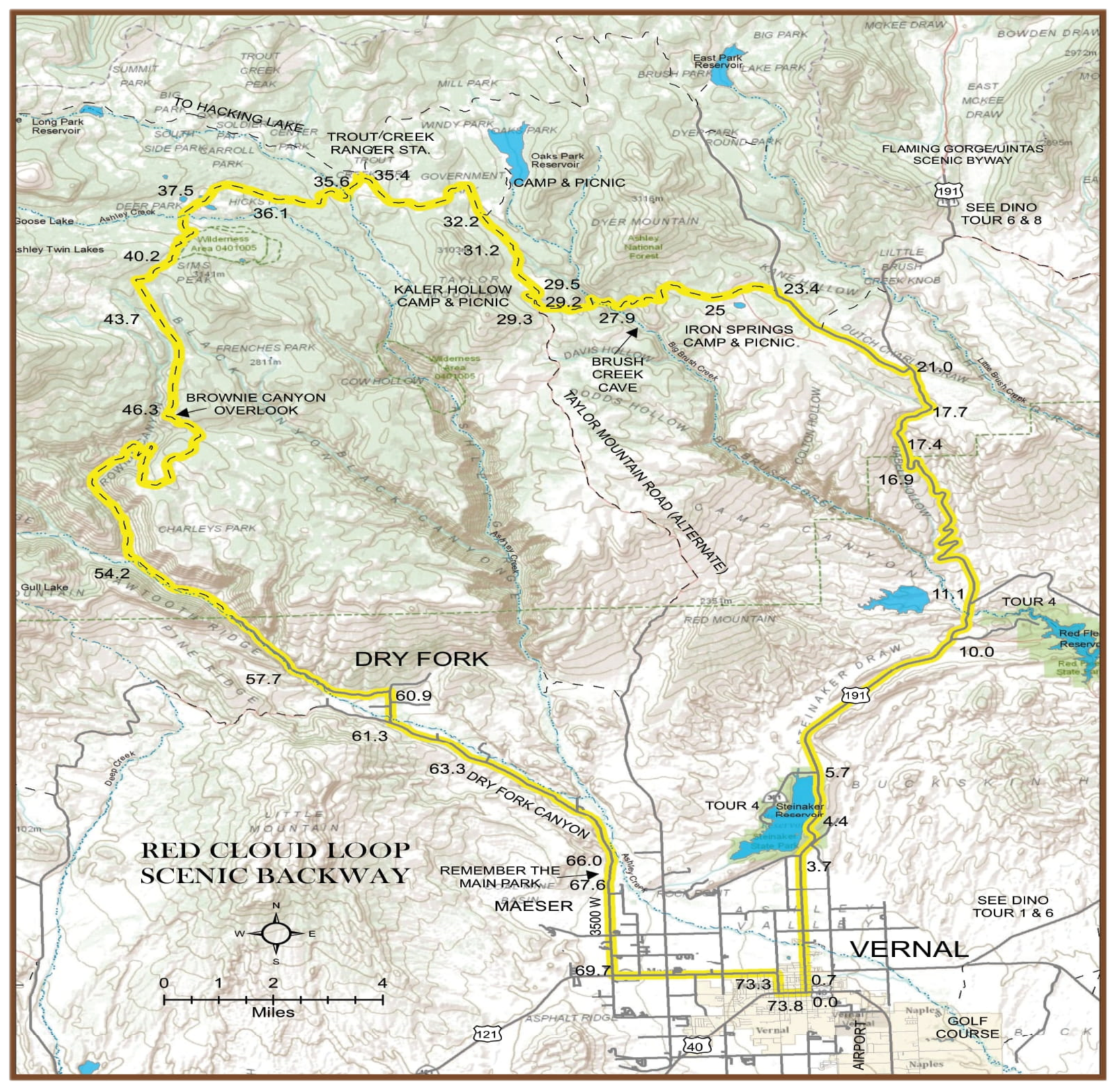Red Cloud Loop Scenic Backway
CAUTION: About half of this tour is over unpaved roads which are rough at best and muddy during bad weather. Advisable to check on road conditions.
Actual driving time: 3hrs.
Total mileage: 73.8.

Mileage
0 Tour begins at the main intersection in Vernal-Main and Vernal Avenue. Begin by leaving Vernal on US 191, Flaming Gorge/Uintas Scenic Byway.
0.7 Information-Vernal U.S. Forest Service District Office. No Services are available after leaving Vernal.
3.7 The first of 20 geology signs along the route point out the various formations.
4.4 Just 4.4 miles from Vernal you will see Steinaker Lake, State Park. Trout fishing, boating, swimming beach, and excellent picnic facilities are available here. Fee.
5.7 Junction-tour continues ahead. (Left to Steinaker State Park). 10 Junction-tour continues ahead. (Right to Red Fleet Lake State Park, boat ramp, and camping area.)
11.1 Junction-tour continues ahead. Brush Creek and Simplot Phosphates Company. (Left to Simplot Phosphates.) The trees that cover the mountainside in this area are juniper, or in Utah terms “cedars.” In this area, these cedars usually begin at about a 5,500 ft. elevation running to about 7,000 ft. These cedars are used as forage by deer during the winter season. However, as the grasses appear in the spring at higher elevations, deer usually leave the cedars and go to the higher elevations for the preferred browse. Other than spring wildflowers, the only other plant life in this area is hardy grass and some sagebrush.
16.9 Windy Point Scenic Byway Overlook-a good panoramic view of the Ashley Valley below. Beyond is the beginning of the Book Cliffs to the south. The red formations immediately below and somewhat to the left are formations that resemble ships and are called the Red Fleet. Ashley Valley was named after William Ashley who explored this country in the early 1800s as a mountain man and trapper. At this point, we leave the cedar-covered area, which opens up into open sagebrush country, a favorite wintering area for elk. This is also the beginning of pinon pine, ponderosa, and quaking aspen.
17.4 Entering Ashley National Forest.
17.7 Highway follows the rim of Hole-in-the Wall Canyon-a typical gorge running down out of the Uinta Mountains. The browse that you can note at this elevation is serviceberry and bitterbrush, favorites of deer.
21.0 Junction-turn left for Red Cloud Loop Scenic Backway. The tour here leaves US 191, the Flaming Gorge/Uintas Scenic Byway which continues on to Flaming Gorge. The Ashley National Forest which you are touring through now follows the multiple-use concept and is open for camping, picnicking, or hiking on the the many trails that are marked in this area. You’ll now see the change in vegetation to mostly lodgepole pine.
23.4 Junction-turn left on the gravel road for Red Cloud Loop. (Paved road to East Park Reservoir). Some of the wildlife that inhabits this forest in addition to the deer and elk mentioned are bobcats, coyotes, a few mountain lions, bears, squirrels, yellow-bellied marmots, and some snow-shoe hares.
25.1 Iron Springs Campground.
27.9 Big Brush Creek-this is a typical good trout-fishing stream.
29.2 Kaler Hollow Campground.
29.3 Junction-Red Cloud Loop continues straight ahead (left returns to Vernal over Taylor Mountain).
29.5 Kaler Hollow. This is the site of an old CCC Camp of the 1930s.
31.2 Government Creek and Park.
32.2 Turnoff to Oak’s Park Reservoir-Red Cloud Loop continues straight ahead. (Oak’s Park Reservoir is a favorite fishing reservoir and has good camping and picnic facilities. It is just a mile off the highway.)
35.4 Junction-Red Cloud Loop continues straight ahead (right to Trout Creek Ranger Station, Trout Creek, and Trout Creek park. Good small trout in this stream.)
35.6 Junction-Red Cloud Loop turns left (right to Hacking Lake where the road ends).
36.1 North Fork of Ashley Creek-this is also good fishing, camping, and picnic area.
37.5 Straight ahead is a good view of Leidy Peak, one of the higher peaks of the Uintas (12,020 feet).
40.2 South Fork of Ashley Creek-another good trout fishing stream, camping, and picnic area.
43.7 Junction-Red Cloud Loop straight ahead. (Right to Ashley Twin Lakes.)
46.3 Lookout point looking down into Brownie Canyon. This is a typical view of the High Uinta Range, and includes the pine and aspen forest with the deep canyons. Begin descent down into Brownie Canyon which drops several thousand feet in just a few miles.
54.2 Junction-Red Cloud Loop continues straight ahead. For the next several miles the road follows the bottom of Dry Fork Canyon where there are numerous picnic and camping areas.
57.7 You’ll notice numerous cottonwood and willow trees as well as a few pine and aspen growing along the creek bottom. The stream that runs down Dry Fork Canyon goes underground at various points which leaves the creek bed dry and is the reason for the name Dry Fork.
60.9 Center of Dry Fork Settlement which in the early days of settling Ashley Valley was one of the more sizeable settlements in the area. The town of Dry Fork was under the protection of old Fort Thornburg which was located just south of the settlement in Dry Fork Canyon.
61.3 Junction-Red Cloud Loop continues on to the left (right to Deep Creek and Lapoint).
63.3 Turnoff to Sadie McConkie Ranch and Native American petroglyphs. These petroglyphs are one of the best displays in the area. (See Tour #2)
66.0 Turnout for viewing “Remember the Maine” on the face of the cliff. Also picnicking and playground.
67.6 Leaving Dry Fork Canyon and entering Ashley Valley.
69.7 Junction-turn left on Maeser Highway (500 No.). Return to Vernal (right fork to Lapoint).
73.3 Intersection-Vernal Main Street. Turn left to the center of town.
73.8 End of tour
